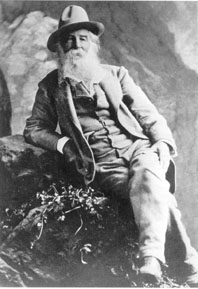Walt Whitman, the second of nine children, was born 31 May 1819 in West Hills, Long Island, to parents of Quaker background. In 1823 the family moved to Brooklyn, where for six years Whitman attended public schools. It was the only formal education he ever received. At age eleven he worked as an office boy for lawyers and a doctor, then in the summer of 1831 became a printerís devil for the Long Island Patriot. Unsuccessful in trying to land a job as a compositor he rejoined his family, who in the meantime had returned to Long Island.

BY WALT WHITMAN
Published: June, 2000
Walt Whitman, the second of nine children, was born 31 May 1819 in West Hills, Long Island, to parents of Quaker background. In 1823 the family moved to Brooklyn, where for six years Whitman attended public schools. It was the only formal education he ever received. At age eleven he worked as an office boy for lawyers and a doctor, then in the summer of 1831 became a printer’s devil for the Long Island Patriot. Unsuccessful in trying to land a job as a compositor he rejoined his family, who in the meantime had returned to Long Island.
On Long Island he taught at several schools and in 1838-1839 edited Long Islanders. The next few years he alternated between teaching school and contributing or editing newspapers in Long Island, Brooklyn, and New York. This journalistic activity expanded to the point that between 1841 and 1850 he either edited or contributed to over thirteen newspapers and magazines in the greater New York area. In 1848 he journeyed to New Orleans and worked a short stint with the New Orleans Crescent, the first of a number of journeys he would make to familiarize himself with the breadth of America.
Among the newspapers and magazines with which Whitman was associated, the New York Aurora and the Democratic Review especially provided him important opportunities to acquaint himself with the world of literature. Between 1848 and 1855 Whitman lived mostly in Brooklyn with his family, where he operated a printing office and stationery store and occasionally contributed to newspapers. It was during this period that Whitman made frequent use of the Fulton Ferry. In July of 1855 the first edition of Leaves of Grass was published by Rome Brothers in Brooklyn. Whitman continually added more poems to the volume, tinkered with others already included, and revised the book’s structure. The number of editions totaled seven by the time of his death on 26 March 1892.
The preface to the 1855 edition of Leaves of Grass has since become one of the most famous manifestos in literature. It is a lyrical statement of belief in the possibility of a democratic poetry for America and in the inevitable emergence of a poet who will be a bard to the people. To Whitman, honest expression would spontaneously dictate form and rhythm: "The rhyme and uniformity of perfect poems show the free growth of metrical laws and bud from them as unerringly and loosely as lilacs or roses on a bush, and take shapes as compact as the shapes of chestnuts and oranges and melons and pears, and shed the perfume impalpable to form."
In January 1873 he suffered a partial paralytic stroke which compelled a move to Camden, New Jersey. On the evening of 26 March 1892 Whitman died.
Whitman wrote of his passion for ferries:
Living in Brooklyn or New York City, my life was curiously identified with the Fulton ferry, already the greatest of its sort in the world for general importance, volume, variety, rapidity and picturesqueness. Almost daily, I cross’d on the boats, often up in the pilot houses where I could get a full sweep, absorbing shows, accompaniments, surroundings. What oceanic currents, eddies underneath – the great tides of humanity, also, with ever-shifting movements. Indeed, I have always had a passion for ferries; to me they afford inimitable streaming, never-failing, living poems. The river and the bay scenery, all about New York island, any time of a fine day – the hurrying, splashing sea-tides – the changing panorama of steamers, all sizes, often a string of big ones outward bound to distant ports – the myriad of what-sail’d yachts – what refreshment of spirit such sights and experiences gave me.
He put his feelings into poetry with his seminal poem "Crossing Brooklyn Bridge", included as part of his 1856 version of Leaves of Grass. Preparing to write the poem he mused in November, 1849:
You and I, reader, and quite all the people who are now alive, won’t be much thought of a hundred years from now but the world will be just as jolly, and the sun will shine as bright, and the rivers will slap along their green waves, precisely as now; and other eyes will look upon them about the same as we do now".
Unconsciously, he had begun to rehearse "Crossing Brooklyn Ferry". The ferry plying between Brooklyn and Manhattan also plied between now and forever, the one and the many:
It avails not, time nor place -- distance avails not, I am with you, men and women of a generation, or ever so many generations hence, Just as you feel when you look upon the river and sky, so I felt Just as any of you is one of a living crown, I was one of a crowd, Just as you are refresh’d by the gladness of the river and the bright flow, I was refresh’d. Just as you stand and lean on the rail, yet hurry with the swift current, I stood yet was hurried, Just as you look on the numberless masts of ships and thick-steamm’d pipes of steamboats, I looked.

